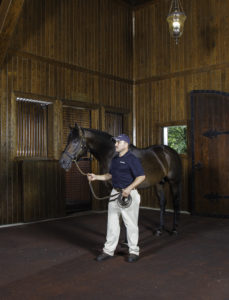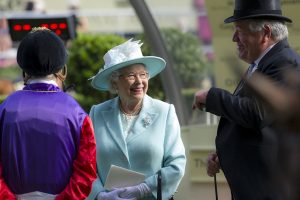It’s a tribute to the O’Callaghan family’s record for ‘making’ stallions – and to Scat Daddy’s magnificent achievements with his European runners – that El Kabeir received a warm welcome when he took up stud duties at Yeomanstown Stud in 2018.
Billed as “Scat Daddy’s best ever two-year-old son to race in America” and priced at €8,000, the six-year-old attracted nearly 150 mares, even though his record established him firmly as a dirt specialist. This support is now translating into a solid start to El Kabeir’s stallion career.
His first black-type success came when Don Chicco, a son of an unraced Oasis Dream mare, won the Premio Giuseppe de Montel at San Siro in June. El Kabeir didn’t have long to wait for his next notable performer, thanks to Masekela, a 30,000gns yearling out of a 12-furlong Group 3 winner. After failing by only a short head to catch the future Group 1 winner Native Trail in the Group 2 Superlative Stakes, Masekela followed up with a head victory over the future Group 2 winner Bayside Boy in the Listed Denford Stakes at Newbury.
Another son – the Irish gelding Rerouting – was the next to gain black type, when third in the Group 3 Solario Stakes, but the distinction of being El Kabeir’s leading earner falls to the quirky Harrow. A son of a five-furlong winner at Wolverhampton, Harrow was recording his third consecutive success when he got the better of Ever Given in the Weatherbys Scientific £200,000 2-Y-O Stakes at Doncaster.

Scat Daddy: late stallion continues to exert a major influence | Photo: Coolmore
El Kabeir – whose name apparently translates as The Boss – had also been very effective as a two-year-old, but he wasn’t in the same mould as the likes of No Nay Never, Caravaggio, Lady Aurelia, Sioux Nation and Acapulco, all of whom made their name over five or six furlongs. It was over seven furlongs, on his second start at Saratoga, that El Kabeir recorded a nearly 11-length victory at Saratoga, in which he led throughout.
The remainder of his juvenile career was spent in Graded stakes events. He made amends for two disappointing efforts on sloppy/muddy tracks when he tackled two turns for the first time, in the Group 2 Kentucky Jockey Club Stakes over an extended mile at the end of November. He again led throughout and he hung on to win by a short-head.
Those five juvenile starts earned El Kabeir a weight of 118 on the year-end Experimental Free Handicap, 8lb below the equal top-weights American Pharoah and Texas Red. El Kabeir’s owners, Zayat Stables, also owned American Pharoah, who was to dominate the Triple Crown races. El Kabeir never made it to the Classics but he was kept busy in the first few months of his second season, notably winning the Grade 3 Jerome Stakes in January and the Grade 3 Gotham Stakes in March, both over an extended mile.
The colt’s staying-on third in the Grade 1 Wood Memorial encouraged his trainer John Terranova to talk of the Kentucky Derby as a possible target, but El Kabeir didn’t race again until the end of October.
“El Kabeir’s early results must lend encouragement to Coolmore, who have invested heavily Scat Daddy’s highest-ranked son Justify”
Unfortunately, he rarely regained his former high standard during this latter part of his career. His only success in his remaining 11 starts came when he scrambled home as a short-priced favourite in a seven-furlong Listed race at Laurel. He had little to show for being kept in training at the ages of four and five and a change of trainers and even a change of surface did nothing to revive his fortunes.
His one appearance on turf, in a Grade 2 at Pimlico, saw El Kabeir finish only seventh of eight, so he is unusual among European stallions in that dirt was his preferred surface. But then, it was also the preferred surface for his sire Scat Daddy, who never ventured onto turf.
El Kabeir’s early results must lend encouragement to the Coolmore team, who have invested heavily in their belief that Scat Daddy’s highest-ranked son, the 2018 Triple Crown winner Justify, is going to match Scat Daddy’s prowess and versatility as a sire. Of course, few horses proved as versatile as Scat Daddy’s own sire, Johannesburg, whose juvenile career saw him become a top-level winner in four different countries, scoring not only on dirt in the Breeders’ Cup Juvenile but also on turf tracks ranging from firm to good to soft.
Coolmore’s faith in Scat Daddy’s stallion sons has already been boosted by some of his eldest sons. No Nay Never was the leading first-crop sire of 2018, thanks to the likes of Ten Sovereigns and Land Force, and now Caravaggio is holding third place in what appears to be a close-fought battle for this year’s title of champion first-season sire.
Caravaggio already has his first three black-type winners under his belt, thanks to Agartha, who has consistently proved herself one of Ireland’s leading juvenile fillies, Dizzy Bizu, a Listed winner in France, and Her World, a highly regarded Wesley Ward-trained filly who was an impressive winner of the Tyro Stakes at Monmouth on her debut in August.
Caravaggio’s switch from Coolmore to Ashford before the 2021 season may eventually prove helpful to Sioux Nation, the 2017 Phoenix Stakes winner who certainly won’t be short of ammunition when his first crop reaches the races in 2022.
As for El Kabeir, he is likely – as so many young stallions do – to find it more difficult to maintain his progress with his second and third crops. Having sired 118 foals in his first season, he was bred to 87 mares in his second year and to around 70 in his third. However, his fellow Yeomanstown stallion Dark Angel has proved that a stallion can survive dwindling support in his early years if he’s good enough, and El Kabeir’s early results hint that he also has sufficient talent.



